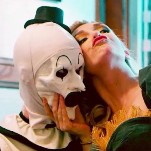Ballroom Dancing Is Backstabby, Brutal
LatestWith all those flowing and feathery outfits and graceful twirls, ballroom dancing certainly looks lovely. But real-life dancer Hanna Louise Annetts tells us not to be fooled by all that elegance and class for-show: the culture is nasty and sexist.
Writing for The Mail, Annetts paints a Halloween-scary picture of the competitive ballroom dancing scene: Snotty comments about her outfits, physical attacks, and heated competition over coveted male partners have led her to take a “keeps to herself” approach toward the social aspects of her profession. “Sisterly it certainly isn’t and sabotage is rife,” she writes. “I’ve been left battered and bruised as rival dancers have ‘accidentally’ pressed their stiletto heel into my foot or jabbed me in the ribs with their elbows.”
-

-

-

-

-

-

-

-

-

-

-

-

-

-

-

-

-

-

-

-

-

-

-

-

-

-

-

-

-

-

-

-

-

-

-

-

-

-

-

-








































